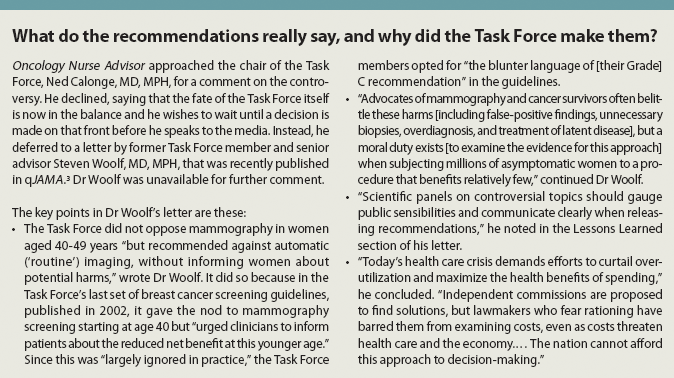In addition, many groups are not changing their own recommendations and approach to breast cancer screening. For example, in a November 16, 2009, statement, the American Cancer Society’s chief medical officer, Otis W. Brawley, MD, said, “The American Cancer Society’s medical staff and volunteer experts overwhelmingly believe the benefits of screening women aged 40 to 49 outweigh its limitations.” The American Medical Association, the National Comprehensive Cancer Network (NCCN), the American Society of Breast Surgeons, the Oncology Nursing Society (ONS), the Society of Breast Imaging, and the American College of Surgeons are among the other associations that still call for yearly screening mammography in all women starting at age 40.
One of the few medical groups defending the Task Force is the American College of Physicians (ACP). In a November 24, 2009, statement, ACP president, Joseph W. Stubbs, MD, said, “ACP urges Congress, the administration, and patient and physician advocacy groups to respect and support the importance of protecting evidence-based research by respected scientists and clinicians from being used to score political points that do not serve the public’s interest.”
WHERE DOES THIS LEAVE NURSES AND PATIENTS?
Amid the continuing debate over the Task Force’s recommendations—including a letter by former Task Force member Steven Woolf, MD, MPH, published in the January 13, 2010, issue of JAMA attempting to clarify what the breast cancer screening guidelines actually said (What do the recommendations really say?)3—knowing what to do can be difficult for nurses and patients. This is particularly true in the face of other guidelines—such as the new guidelines for Pap tests for cervical cancer from the American College of Obstetricians and Gynecologists that recommend more restrictive criteria for treatment or screening (Cervical cytology screening).4


Oncology Nurse Advisor turned to several experts and nurses in the trenches to learn what sources of authority and information they are relying on and what stance they and their institutions are taking. All say that it is business as usual, with annual screening mammography for women aged 40 and older. This is because, they note, every woman is at some risk of developing breast cancer.
“The ONS position has been and continues to be that mammography has to be dealt with on an individual basis. Because screening recommendations aren’t really ‘one size fits every person’, they still have to be individualized,” said Brenda Nevidjon, RN, MSN, president of the ONS and Clinical Professor and Director, Nursing & Healthcare Leadership, School of Nursing, Duke University, Durham, NC. “So it’s very important for nurses to discuss this with every patient, to talk about her specific risk level and explain the importance of screening mammography after age 40. This is one of our responsibilities as nurses, as providers of patient education and patient support.”
She added that one possible unintended side effect of the Task Force recommendations could be a reduction in the number of disadvantaged women getting mammograms. “We’re still not fully screening all women who should be screened and even have insurance coverage to be screened. And the concern is, will the new recommendations lead to more women saying, ‘Why bother?'” wondered Ms Nevidjon.
Therese Bevers, MD, also takes this approach rather than supporting the Task Force’s recommendations. Dr Bevers chairs the NCCN’s breast cancer screening and diagnosis guideline panel. She also is the medical director of the Cancer Prevention Center at the M.D. Anderson Cancer Center, Houston, Texas, and a professor of clinical cancer prevention there.
“I asked women in my clinic for about a week and a half after the guidelines came out, ‘Would you be willing to undergo an unnecessary biopsy so that fewer women will die of breast cancer—[even though] it may not be you, it may be other women [who die of breast cancer]?'” said Dr Bevers. “And there was never a hesitation [among any of the women]. They all said, ‘Absolutely, if it means that fewer women are dying from it.'”